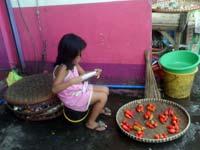Millions of young kids work in Philippines

The Philippines has “The Batang Malaya: Child Labour Free Philippines” which aims to end the worst forms of child labour in the Southeast Asian nation by 2016.
Through the new campaign, the National Child Labour Committee, chaired by the Department of Labour and Employment, has called for “urgent actions” on child labour, reported the Manila Bulletin.
This includes the act of institutionalizing the Survey on Children to regularly monitor progress; strengthening and rationalizing the operations of the National Child Labour Committee by giving it a legal mandate, budget and a dedicated secretariat; improving enforcement of RA 9231 to ensure that all persons found to be engaging children in the worst forms of child labour are penalized; expanding the reach and strengthen the capacity of the labour inspectorate to monitor child labour even in unregulated sectors; and finally mainstreaming child labour in local development plans and integrating it as a condition in programs to reduce poverty including conditional cash transfers.
The 2011 Survey on Children of the National Statistics Office (NSO) revealed that out of 29 million Filipino children aged 5 to 17, roughly 5.5 million working children, of which almost three million were in hazardous child labour.
“Of this number, more than 55.1 percent or 3.02 million were counted as child labour while 2.99 million are exposed to hazardous form of child labour,” Labour and Employment Secretary Rosalinda Baldoz said.
The survey, conducted by the support of the International Labour Organization (ILO), is the first survey that utilized the ILO framework for statistical identification of working children, or children in employment, child labour, and hazardous child labour.
Baldoz said they will use the results of the survey as a baseline for a more responsive programming against child labour in general and hazardous child labour.
According to the ILO, hazardous child labour is defined as being likely to harm children’s health, safety or morals by its nature or circumstances. Children may be directly exposed to obvious work hazards such as sharp tools or poisonous chemicals. Other hazards for child labourers may be less apparent, such as the risk of abuse or problems resulting from long hours of work. Hazardous work is considered as one of the worst forms of child labour.
Boys are subject to more hazardous child labour, raking in 66.8 percent as compared to girls with 33.2 percent.
Meanwhile, regions which have the highest incidence of hazardous child labour are Central Luzon (10.6 per cent), Bicol (10.2 per cent), Western Visayas (8.5 per cent), Northern Mindanao (8.2 per cent) and Central Visayas (7.3 percent).
“We have to get to the root of child labour which is linked with poverty and lack of decent and productive work. While we strive to keep children in school and away from child labour, we need to ensure decent and productive work for parents and basic social protection for families,” said Director Lawrence Jeff Johnson of the International Labour Organization (ILO) Country Office for the Philippines.
In 2001, there were reportedly 4 million working children, of which 2.4 were in hazardous child labour while in 1995, there were 3.6 million working children, of which 2.2 were in hazardous child labour. Though numbers decreased during this time, the same cannot be said for the previous findings of the NSO.
There were revisions and improvements in capturing the overall picture of child labour in the Philippines. The 2011 Survey on Children used terms under Republic Act 9231 on the worst forms of child labour enacted in 2003 and international statistical standards adopted in 2008.
Although the survey is more comprehensive, it still cannot estimate children trafficked for work, forced and bonded child labour, commercial sexual exploitation of children and use of children for illicit activities and armed conflict.
“What is crucial now is to tackle and to monitor progress in reducing child labour on a regular basis. One of the recommendations is to conduct the survey every five years to immediately find solutions and provide interventions. Results of this survey will be used as targets for interventions both geographically and among specific groups by industry occupations. It is not just the role of the government, employers and workers organizations, but also local communities since child labour often happen in unregulated sectors,” said Johnson.
Globally, there were 215 million documented cases of children trapped in child labour in 2010. There has been progress in efforts to reduce child labour worldwide.
Leave a comment






